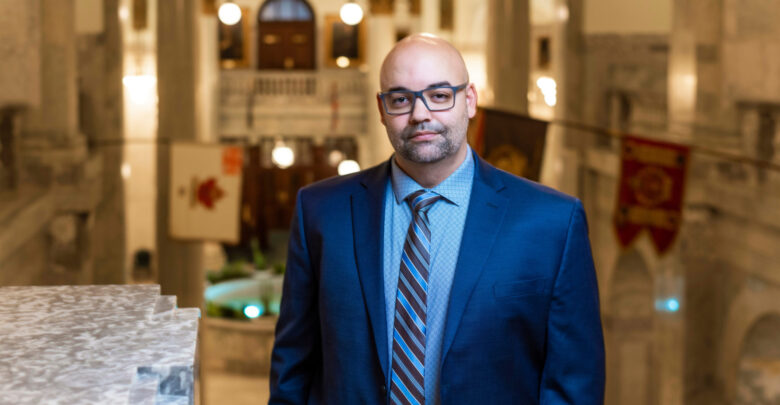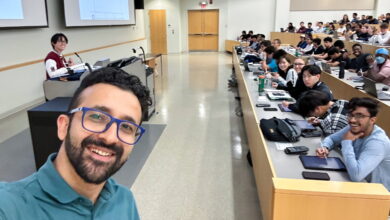U of A professor’s expert opinion catches the notice of Jason Kenney
Former Premier Jason Kenney criticized a news article featuring political scientist Jared Wesley as being unbalanced and an example of “agitprop.”
 John Ulan/Ulan Photography
John Ulan/Ulan PhotographyOn matters of current events it’s common for journalists to reach out to academics to lend an expert perspective. Recently, University of Alberta political science professor Jared Wesley was asked to do just this in an article on the Government of Alberta’s recent use of the notwithstanding clause.
Published on October 28 by CTV Edmonton and written by Angela Amato, the article ended up catching the attention of former Alberta Premier Jason Kenney. In a post made to his X account on October 29, Kenney criticized the story as lacking balance and only platforming the voices of those on the political left.
He questioned why “we see so much agitprop like this masquerading as news from so many legacy media outlets?” Agitprop is a shortened name for the Soviet Union’s Department for Agitation and Propaganda.
The article’s title originally referred to Wesley and the other interviewees as “experts,” a title Kenney did not see as accurate. Later, CTV issued a correction to refer to Wesley and the other interviewees as critics.
“A more accurate headline would be ‘Four people on the left angry about use of notwithstanding clause.’ Which is the opposite of news. It’s the ultimate ‘Dog Bites Man’ non-story,” Kenney’s post read.
Kenney’s post “dismissive of conservative viewpoints that don’t correspond with partisan interests,” Wesley says
When he saw Kenney’s post, Wesley was disappointed for a number of reasons. Firstly, he said Kenney framed the issue “as a matter of journalistic integrity.” Secondly, he found the post “unduly polarizing.” And thirdly, Wesley found Kenney’s post “dismissive of conservative viewpoints that don’t correspond with partisan interests.”
Although he does not explicitly name Wesley, Kenney refers to him in his post as a “left wing academic,” a description Wesley said is unnecessary and not accurate. Formerly, Wesley was a card-carrying member of the United Conservative Party (UCP), something he stated in a post he made in response to Kenney. Additionally, Wesley said the position he took in Amato’s article was “actually a conservative one.”
By labelling Wesley and the other interviewees as left wing, Kenney “effectively short cut any kind of debate over the use of the notwithstanding clause,” Wesley said.
“And I think more worrisome is that by labelling opponents as lefties, he dismisses some very serious dissension within the conservative movement, which right now is struggling to gain traction in the mainstream media.”
UCP “hiding behind this justification that because they could, they must, and they should,” Wesley says
Use of the notwithstanding clause is protected in the Canadian Charter of Rights and Freedoms. The question isn’t about whether the government can use the notwithstanding clause, but whether they should, Wesley said.
“I think a lot of folks that align with Kenney are used to conflating ‘well we can, therefore we must, and therefore it’s a good thing.”
Wesley described his position on the clause as the same as Peter Lougheed’s. Lougheed, a former Alberta premier, was one of the premiers responsible for negotiating the clause into the charter back in 1982. There has been ongoing debate about whether Lougheed would or would not have supported the UCP’s use of the notwithstanding clause.
“It should be used as a clause of last resort, and it should only be used after a government has made a good faith case in defense of their law as being reasonable in a free and democratic society,” Wesley said.
In the most recent use of the notwithstanding clause, Wesley said there was a lack of both legislative debate and measures to minimize the impact of the breach of charter rights on the most affected.
“So my critique of the UCP is not that they used the notwithstanding clause, but that they’re hiding behind this justification that because they could, they must, and they should,” Wesley said. “Those three things are completely separate and ought to be debated in a free and democratic society. They robbed us of that ability by fast tracking the bill and passing it at 2:00 a.m. while the premier was sitting in an airport lounge on her way to Saudi Arabia.”
Accepting the most recent use of the notwithstanding clause is how policy making cultures shift, Wesley says
Amongst supporters of Bill 2, Wesley has noticed the argument “we’ve done it and let’s all just move on.” The risk of accepting this use of the notwithstanding clause is that it could become a “regular tool in the policy toolkit,” Wesley said.
“I’m not given to too many slippery slope arguments, but this is how policy making cutlures shift. When we all accept that it’s okay, it’s not me, it’s not my rights that are being taken away today.”
According to Wesley, proponents for the use of the notwithstanding clause have argued that the ends justifies the means. This is “fundamentally unconservative,” Wesley said.
“Conservatives care about processes that are tried and true. They care about constitutional customs and norms, and this government has shown no respect for others.”
In his post, Kenney states that Amato’s article is “an object lesson for why trust in legacy media has plummeted, and alt-right media audiences have grown.” According to Wesley, statements like this serve to undermine the free press and are not in line with conservative traditions Kenney previously supported.
“I also think the days when conservative politicians would get bad press but still respect the journalists that did it are long gone.”
The Gateway asked Kenney for comment but did not receive a response before publication.




